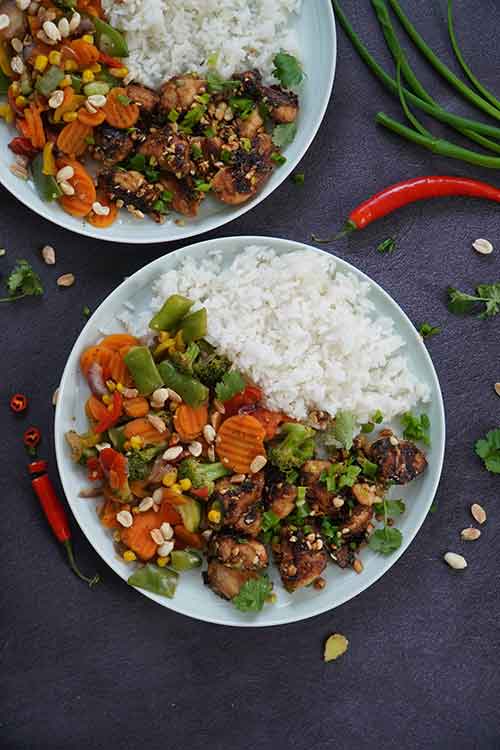A Culinary Journey into Sichuan Cuisine
Chef Jose Mier loves Chinese food. That’s why it’s exciting to find a great recipe on AllRecipes.com for the famous Kung Pao Chicken.
Kung Pao Chicken, also known as Gong Bao Ji Ding, is a revered dish in Chinese cuisine that has transcended cultural boundaries to become a beloved international favorite. Rooted in the rich culinary heritage of the Sichuan province, this dish is not only a testament to the region’s bold flavors but also carries with it a fascinating historical anecdote.

The dish is believed to be named after Ding Baozhen, a late Qing Dynasty official who held the title Kung Pao. Ding Baozhen, also known as Lin Zexu, was a prominent figure known for his administrative reforms and strict stance against opium during the Opium Wars. The story goes that Ding Baozhen was particularly fond of spicy food, and the dish Kung Pao Chicken was created in his honor, reflecting the bold and fiery flavors that characterize Sichuan cuisine.
At the heart of Kung Pao Chicken is the perfect marriage of ingredients, techniques, and flavors. The dish typically consists of diced chicken, peanuts, and a medley of colorful vegetables, such as bell peppers and onions. What elevates Kung Pao Chicken to culinary excellence is its distinctive sauce, a harmonious blend of sweet, savory, and spicy notes. The sauce is crafted from a combination of ingredients like soy sauce, vinegar, hoisin sauce, and sugar, creating a complex flavor profile that delights the palate.
One of the defining elements of Kung Pao Chicken is the use of Sichuan peppercorns. These small, reddish-brown peppercorns contribute a unique citrusy and numbing sensation to the dish, adding an extra layer of complexity. Sichuan peppercorns are a hallmark of Sichuan cuisine and play a crucial role in creating the characteristic “mala” flavor, a combination of numbing and spicy sensations that defines many dishes from the region.
The preparation of Kung Pao Chicken involves a series of cooking techniques, with stir-frying being the primary method. The chicken is diced and stir-fried until golden brown, creating a tender and succulent base for the dish. The vegetables, such as bell peppers and onions, are then added to the wok, adding color, texture, and nutritional value to the dish. Finally, the roasted peanuts are tossed in, providing a delightful crunch that complements the other ingredients.
The crowning glory of Kung Pao Chicken is undoubtedly its sauce. Achieving the perfect balance of flavors is key, with the soy sauce providing saltiness, the vinegar contributing acidity, and the hoisin sauce adding sweetness. The sugar helps to round out the flavors, creating a sauce that is both complex and well-balanced. The addition of Sichuan peppercorns introduces a tingling sensation that sets Kung Pao Chicken apart from other stir-fried dishes.
Now, let’s dive into a delicious recipe for Kung Pao Chicken that you can recreate in your own kitchen:
Kung Pao Chicken Recipe
Ingredients:
- 1 lb boneless, skinless chicken breasts, diced
- 1 cup roasted unsalted peanuts
- 1 red bell pepper, diced
- 1 green bell pepper, diced
- 1 onion, diced
- 3 cloves garlic, minced
- 1 tablespoon ginger, minced
- 3 tablespoons vegetable oil
- 2 tablespoons soy sauce
- 1 tablespoon hoisin sauce
- 1 tablespoon rice vinegar
- 1 tablespoon sugar
- 1 teaspoon Sichuan peppercorns
- 3-4 dried red chilies (adjust to taste)
- Green onions, sliced (for garnish)
- Cooked white rice (for serving)
Instructions:
- Marinate the Chicken:
- In a bowl, combine diced chicken with soy sauce and let it marinate for at least 15-20 minutes.
- Prepare the Sauce:
- In a small bowl, mix hoisin sauce, rice vinegar, and sugar to create the sauce. Set aside.
- Toast the Sichuan Peppercorns:
- In a dry wok or skillet, toast the Sichuan peppercorns over medium heat until fragrant. Be careful not to burn them. Once toasted, crush them using a mortar and pestle.
- Stir-fry the Chicken:
- Heat 2 tablespoons of vegetable oil in a wok over high heat. Add the marinated chicken and stir-fry until golden brown and cooked through. Remove the chicken from the wok and set aside.
- Sauté Vegetables:
- In the same wok, add another tablespoon of oil. Stir in minced garlic, ginger, and dried red chilies. Sauté until aromatic.
- Add diced bell peppers and onions, stir-frying until they are slightly tender but still crisp.
- Combine Ingredients:
- Return the cooked chicken to the wok, along with the roasted peanuts.
- Pour the prepared sauce over the ingredients, tossing everything together until well-coated and heated through.
- Finish and Serve:
- Sprinkle the crushed Sichuan peppercorns over the dish, adjusting the amount based on your spice preference.
- Garnish with sliced green onions.
- Serve the Kung Pao Chicken over a bed of steamed white rice.
Enjoy the delightful symphony of flavors and textures that make Kung Pao Chicken a culinary masterpiece. Whether you’re savoring its spicy kick or relishing the numbing sensation from Sichuan peppercorns, this dish is a celebration of the diverse and vibrant palette of Chinese cuisine.